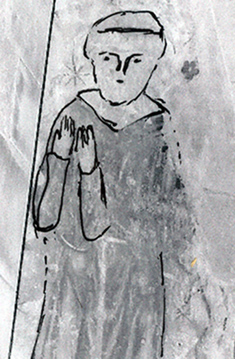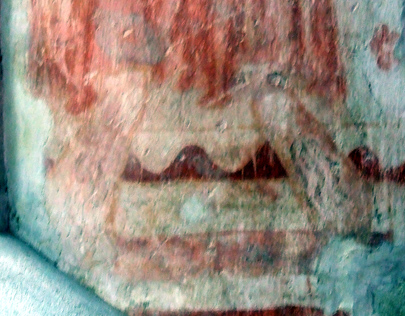Doddington, Kent (†Canterbury) c.1250
St Francis of Assisi with Stigmata

This painting vies with that of the saint at Wissington in Suffolk for the title of earliest painting of St Francis in an English parish church. The Wissington painting (where Francis is shown preaching to the birds) is on a far smaller scale, making comparison more difficult, but I think it is probably a little earlier than this one.

The Doddington St Francis is in a window splay on the north side of the chancel. The saint stands frontally, originally, according to Tristram, with both hands raised, although, Tristram said, one (he does not say which one) has been destroyed.¹ I have to disagree with Tristram here because it seems to me that Francis is holding both hands in an attitude of prayer, across his body at the left, and the small black and white sketch should show this reasonably well. What looks like the ghostly image of his left hand, apparently dangling by his side, is misleading – it may be a pentimento, but the oddly curving position looks awkward and unlikely. The saint’s feet are still bleeding and fairly easy to see, the left foot in particular streaked with blackened blood. Francis’s triple-knotted Franciscan girdle also shows well here. Above the saint’s head (main photo) is part of the wing of the Seraph who inflicted the Stigmata on Francis. You can read the story of the celestial visitation on this site, on the page for Slapton.

This is not the only remaining painting at Doddington. There is another, in an adjacent window splay, of an as yet unidentified saint. I think, despite his crown, this is more likely to be John the Baptist, dedicatee of the church² than King Henry III, but the work of identification goes on.
¹ Tristram 2, p.31
² The church is actually dedicated to John’s beheading, or decollation. There are two or three other such dedications in the UK.